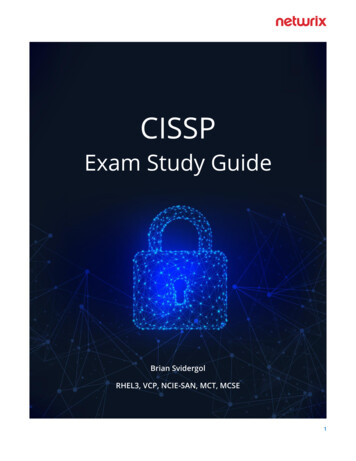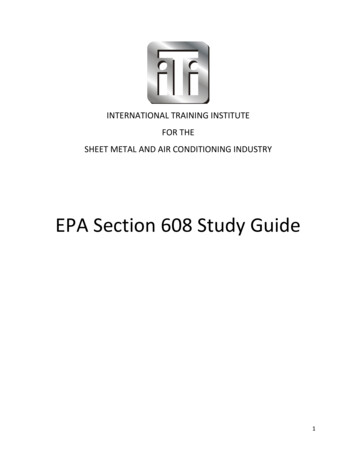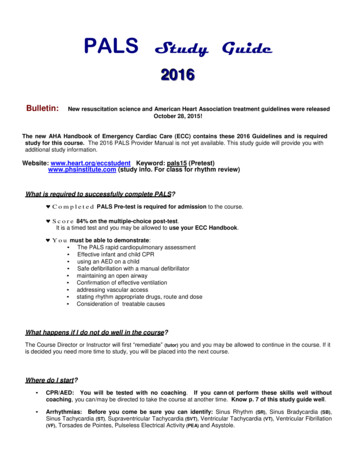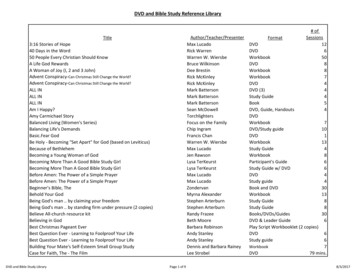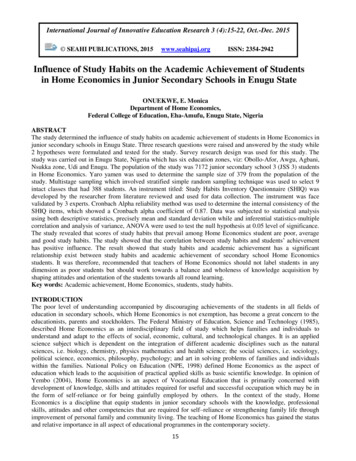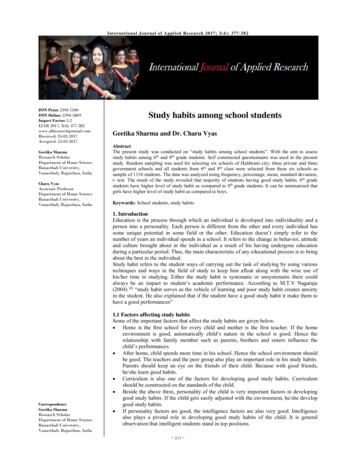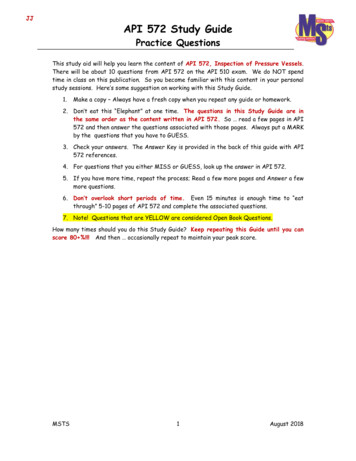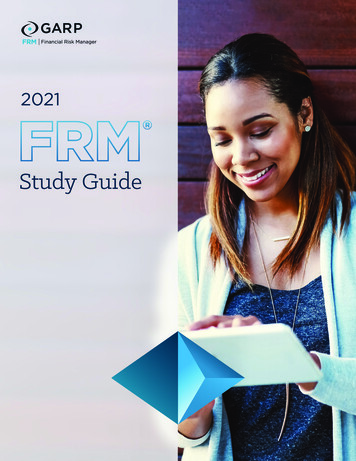
Transcription
2021Study Guide
garp.org/frm3FRM EXAM PART I
2021 Financial Risk Manager (FRM )Exam Study GuideTOPIC OUTLINE, READINGS,TEST WEIGHTINGSThe Study Guide sets forth primary topics and sub-topicscovered in the FRM Exam Part I and Part II. The topicswere selected by the FRM Committee as essential fortoday’s risk managers to master. The topics and theirrespective weightings are reviewed yearly to ensurethe Exams are timely and relevant. The Study Guidealso contains a full listing of all of the readings that arerecommended as preparation for the FRM Exam Part Iand Part II.Key concepts appear as bullet points at the beginningof each section and are intended to help candidatesidentify the major themes and knowledge areasassociated with that section.FRM EXAM APPROACHREADINGSQuestions for the FRM Exams are related to andsupported by the readings listed under each topicoutline. These readings were selected by the FRMCommittee to assist candidates in their review of thesubjects covered by the Exams. It is strongly suggestedthat candidates review these readings in depth prior tositting for each Exam. All of the readings listed in theFRM Study Guide are available through GARP. Furtherinformation can be found on the GARP website.FRM EXAM PREP PROVIDERSSome candidates may want to more formally reviewthe materials with FRM Exam Preparation Providers(EPPs). A list of EPPs that have registered with GARPcan be found on the GARP website. GARP does notendorse any EPP, but merely lists them as a service toFRM candidates.The FRM Exams are practice-oriented. The questionsare derived from a combination of theory, as set forth inthe readings, and real-world work experience. Candidatesare expected to understand risk management conceptsand approaches, as well as the ways in which they wouldapply to a risk manager’s day-to-day activities. It israre that a risk manager will be faced with an issue thatcan immediately be slotted into one category. In thereal world, a risk manager must be able to identify anynumber of risk-related issues and be able to deal withthem effectively.As such, the Exams are comprehensive in nature, testinga candidate on a number of risk management conceptsand approaches.On the following pages, an asterisk after a reading indicates that the reading is freely available on the GARP website.12021 FRM Study Guide
FRM EXAM PART IFRM Exam Part IFOUNDATIONS OF RISK MANAGEMENTQUANTITATIVE ANALYSISFINANCIAL MARKETS AND PRODUCTSVALUATION AND RISK MODELSFRM Exam Part IIMARKET RISK MEASUREMENT AND MANAGEMENTCREDIT RISK MEASUREMENT AND MANAGEMENTOPERATIONAL RISK AND RESILIENCYLIQUIDITY AND TREASURY RISK MEASUREMENT AND MANAGEMENTRISK MANAGEMENT AND INVESTMENT MANAGEMENTCURRENT ISSUES IN FINANCIAL MARKETSgarp.org/frm2
Foundations of Risk ManagementPART I EXAM WEIGHT 20%TOPICS AND READINGSThis area focuses on foundational concepts of risk management and how risk management can add value toan organization. The broad knowledge points covered in Foundations of Risk Management include the following: Basic risk types, measurement, andmanagement toolsCreating value with risk managementRisk governance and corporate governanceCredit risk transfer mechanismsThe Capital Asset Pricing Model (CAPM) Risk-adjusted performance measurementMultifactor modelsData aggregation and risk reportingFinancial disasters and risk management failuresEthics and the GARP Code of ConductTo cover these broad knowledge points, a new proprietary book has been created exclusively for FRM candidates.While detailed learning objectives associated with these readings are presented in the 2021 FRM LearningObjectives document, a brief summary of how to relate these readings to the knowledge points follows.Chapters 1 and 2 explore different risk types, how risks can arise in an organization, and how firms managefinancial risks. Chapter 3 describes the role of corporate governance in risk management, including the role of theboard of directors and other areas of an organization. The concept of risk appetite and how it is translated into a riskappetite framework and communicated throughout an organization is presented as well in this chapter.Chapter 4 presents an overview of credit risk transfer mechanisms, including credit derivatives and securitization,and discusses issues with the securitization of subprime mortgages. Chapter 5 presents Modern Portfolio Theory(MPT) and the CAPM, one of the foundational developments in risk-adjusted pricing and valuation. This is followedby Chapter 6, which explains how the Arbitrage Pricing Theory (APT) and factor models can be used to modelreturns on investment assets.Data is the lifeblood of many large financial organizations, and aggregating and reporting risk data have becomeincreasingly important. Chapter 7 addresses this important topic. Chapter 8 introduces enterprise risk management(ERM), a common and important method for assessing and managing risk in an organizational context, and discussesits future trends.As it is always important to learn from historical experience, Chapter 9 describes various financial disasters fromthe past, and Chapter 10 focuses on the recent Great Financial Crisis (GFC) of 2007-2009.To help ensure ethical standards are upheld in the risk management profession, Chapter 11 contains GARP’s Codeof Conduct, a code that all FRMs are subject to.32021 FRM Exam Part I
FRM EXAM PART IREADINGS FOR FOUNDATIONS OF RISK MANAGEMENTFor 2021, the entirety of the Foundations of Risk Management curated readings has been replaced with GARP’sproprietary Foundations of Risk Management book. The contents of this book are as follows: Chapter 1. The Building Blocks of Risk Management Chapter 2. How Do Firms Manage Financial Risk? Chapter 3. The Governance of Risk Management Chapter 4. Credit Risk Transfer Mechanisms Chapter 5. Modern Portfolio Theory (MPT) and the Capital Asset Pricing Model (CAPM) Chapter 6. The Arbitrage Pricing Theory and Multifactor Models of Risk and Return Chapter 7. Principles for Effective Data Aggregation and Risk Reporting Chapter 8. Enterprise Risk Management and Future Trends Chapter 9. Learning from Financial Disasters Chapter 10. Anatomy of the Great Financial Crisis Chapter 11. GARP Code of Conduct**This reading is freely available on the GARP website.garp.org/frm4
Quantitative AnalysisPART I EXAM WEIGHT 20%TOPICS AND READINGSThis area tests a candidate’s knowledge of basic probability and statistics, regression and time series analysis, andvarious quantitative techniques useful in risk management. The broad knowledge points covered in QuantitativeAnalysis include the following: Discrete and continuous probability distributionsEstimating the parameters of distributionsPopulation and sample statisticsBayesian analysisStatistical inference and hypothesis testingMeasures of correlationLinear regression with single and multiple regressorsTime series analysis and forecastingSimulation methodsTo cover these broad knowledge points, a new proprietary book has been created exclusively for FRM candidates.While detailed learning objectives associated with these readings are presented in the 2021 FRM LearningObjectives document, a brief summary of how to relate these readings to the knowledge points follows.Chapters 1 through 6 introduce fundamental concepts related to probability, statistics, probability distributions,Bayesian analysis, hypothesis testing, and confidence intervals.Regression analysis is an important statistical tool used to investigate relationships between variables. Chapters 7and 8 give a general introduction to single and multiple variable linear regression analysis. Chapter 9 examines modelspecification and potential deficiencies in model specification through the use of residual diagnostics and tests ofstatistical hypotheses.Time series data occur frequently in finance. The next two chapters describe methods for analyzing time series datain order to estimate statistics and extract other meaningful data characteristics. Chapter 10 focuses on modelingstationary time series, while Chapter 11 focuses on modeling nonstationary time series.Dependence and variation are important subjects in risk management. Chapter 12 introduces volatility, correlation,and returns, as well as the properties of these three measures in the context of both normally and non-normallydistributed variables.Simulation methods are used to value and analyze complex financial instruments and portfolios. Chapter 13introduces simulation methods, including Monte Carlo simulation, and the use of bootstrapping. It alsoexplains the advantages and disadvantages of using simulations and the techniques to reduce Monte Carlosampling error.52021 FRM Exam Part I
FRM EXAM PART IREADINGS FOR QUANTITATIVE ANALYSISFor 2021, the entirety of the Quantitative Analysis curated readings has been replaced with GARP’s proprietaryQuantitative Analysis book. The contents of this book are as follows: Chapter 1. Fundamentals of Probability Chapter 2. Random Variables Chapter 3. Common Univariate Random Variables Chapter 4. Multivariate Random Variables Chapter 5. Sample Moments Chapter 6. Hypothesis Testing Chapter 7. Linear Regression Chapter 8. Regression with Multiple Explanatory Variables Chapter 9. Regression Diagnostics Chapter 10. Stationary Time Series Chapter 11. Nonstationary Time Series Chapter 12. Measuring Returns, Volatility, and Correlation Chapter 13. Simulation and Bootstrappinggarp.org/frm6
Financial Markets and ProductsPART I EXAM WEIGHT 30%TOPICS AND READINGSThis area tests your knowledge of financial products and the markets in which they trade — more specifically, thefollowing knowledge areas: Structures and functions of financial institutionsStructures and mechanics of over-the-counter (OTC)and exchange marketsStructure, mechanics and valuation of forwards,futures, swaps, and optionsHedging with derivatives Interest rates and measures of interestrate sensitivityForeign exchange riskCorporate bondsMortgage-backed securitiesTo cover these broad knowledge points, a new proprietary book has been created exclusively for FRM candidates.While detailed learning objectives associated with these readings are presented in the 2021 FRM LearningObjectives document, a brief summary of how to relate these readings to the knowledge points follows.The first chapter describes the structure of commercial and investment banking, the way banks are regulated,the nature of risks they face, the role of capital in providing cushion against losses, and the securitization processfor MBS. Chapter 2 explains the risks and regulations faced by insurance companies, their capital requirements andperformance ratios, as well as the types and key characteristics of pension funds. Chapter 3 introduces mutual funds,exchange-traded funds and hedge funds, and describes various hedge fund strategies and performance measures.Financial derivatives play a key role in risk management. Chapter 4 describes options, forwards, and futures, alongwith the derivatives markets and the risks faced by market participants. The exchange-traded and OTC markets areexplained in Chapter 5. Chapter 6 describes the structures and operations of central counterparties (CCPs), andthe types of risks faced by CCPs. Chapters 7 and 8 explain the mechanics of futures markets and how futures areused for hedging. Chapter 9 describes the foreign exchange markets and explains methods for estimating foreignexchange risk, multicurrency hedging strategies using options, the determination of exchange rates, and the coveredinterest rate parity theorem.The next two chapters provide deeper coverage of financial forwards and futures, including their pricing, and thedetermination of no-arbitrage values for commodity forwards and futures. The following four chapters examineoptions and their use in risk management, including the properties of different options, option market mechanics,multi-option and hedging strategies, and different exotic options.Interest rates and two important classes of fixed income securities are covered in the next three chapters. Chapter16 describes properties of interest rates and explains bond valuation, duration, and convexity, the pricing offorward rate agreements, and the theories of term structure. Chapter 17 describes corporate bonds, their typesand characteristics and credit ratings. Chapter 18 defines mortgages, explains the valuation of MBS pools, andprepayment modeling and calculations of mortgage pool metrics.The last two chapters examine two additional derivative instruments. Chapter 19 describes interest rates and Treasurybonds in relation to forward and futures prices, along with the use of interest rate futures in hedging. The mechanics,types, and the pricing of swaps contracts used for hedging are described in Chapter 20.72021 FRM Exam Part I
FRM EXAM PART IREADINGS FOR FINANCIAL MARKETS AND PRODUCTSFor 2021, the entirety of the Financial Markets and Products curated readings has been replaced withGARP’s proprietary Financial Markets and Products book. The contents of this book are as follows: Chapter 1. Banks Chapter 2. Insurance Companies and Pension Plans Chapter 3. Fund Management Chapter 4. Introduction to Derivatives Chapter 5. Exchanges and OTC Markets Chapter 6. Central Clearing Chapter 7. Futures Markets Chapter 8. Using Futures for Hedging Chapter 9. Foreign Exchange Markets Chapter 10. Pricing Financial Forwards and Futures Chapter 11. Commodity Forwards and Futures Chapter 12. Options Markets Chapter 13. Properties of Options Chapter 14. Trading Strategies Chapter 15. Exotic Options Chapter 16. Properties of Interest Rates Chapter 17. Corporate Bonds Chapter 18. Mortgages and Mortgage-Backed Securities Chapter 19. Interest Rate Futures Chapter 20. Swapsgarp.org/frm8
Valuation and Risk ModelsPART I EXAM WEIGHT 30%TOPICS AND READINGSThis area will test a candidate’s knowledge of valuation techniques a
1 2021 FRM Study Guide 2021 Financial Risk Manager (FRM ) Exam Study Guide TOPIC OUTLINE, READINGS, TEST WEIGHTINGS The Study Guide sets forth primary topics and sub-topics covered in the FRM Exam Part I and Part II. The topics were selected by the FRM Committee as essential for today’s risk managers to master. The topics and their

